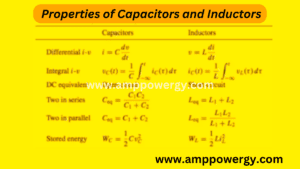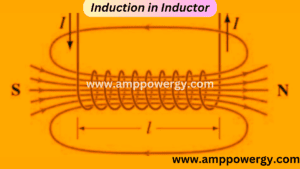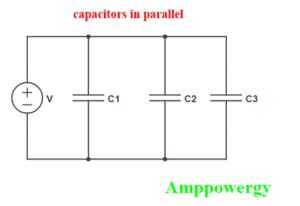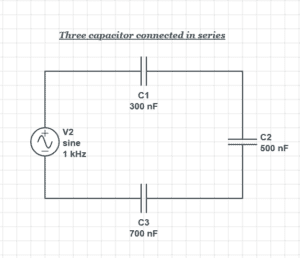What is the Difference between a Capacitor and inductor
Inductors oppose changes in the voltage, but capacitors oppose changes in current. The main difference between capacitor and inductor is that inductor store energy in the form magnetic field while the capacitor store energy in the form of electric field.
Comparision of Capacitor and Inductor
| Inductor | capacitor |
| It opposes current | It opposes voltage. |
| The current in the inductor does not change suddenly. | The voltage in the capacitor does not change suddenly. |
| Its unit is henry. | Its unit is farad. |
| In inductor current lags voltage by π/2 | In capacitor voltage lags current by π/2 |
| In direct current inductor works as a short circuit | capacitor works as a short circuit in alternating current. |
| It stores energy in the form of magnetic field. | it stores electrical energy in the form of electric field. |
Properties of capacitor in inductor

What is Mean by a capacitor?
Capacitor is a device which is used to store energy in the form of electric field. And the capacitance is present due to the separation of conducting surface by a medium.
Take an example of capacitor having two plates. The cross-sectional area of the capacitor is separated by the distance d. Now the gap in between the plates will be the vacuum or it may be filled from some dielectric materials. The dielectric materials can be air, mica, etc. And the impact on capacitance due to dielectric materials i.e., express on constant K.


The capacitance of the capacitor is.
ε0 is the permeability constant of vacuum and the value of ε0 = 8.85 × 10-12 F/m.
There is a dielectric or vacuum between the plate of capacitor which does not allow charge to transfer from one plate to the other. If voltage is applied to the capacitor the change will occur in the charge and it will accumulate on one plate of the capacitor. So, if the charge cannot pass from one plate to the other then the change in the voltage will cause a change in the accumulated charge and this is the equivalent effect of current in the capacitor.
The charge separation is proportional to the applied voltage.
Here C is the capacitance, and it measures the ability of the capacitor that how much charge the capacitor can store. The unit of the capacitor is Farad which is denoted by (F).
The current in the capacitor is “the rate of time in which change comes in the store charge”. That is.
Now to put equation 2 in equation 3 we get
Now to get equivalent I-v relationship for capacitor integrate equation 4.
To calculate Vo which is the initial voltage the formula is follow.
What is an Equivalent capacitance
Equivalent capacitance formula for capacitor is just like resistor. Capacitor can be connected in series and parallel connection.
Now assume two capacitors are connected in series and parallel connection.
The same rule is used for two capacitors that are connected in series, which is used for two resistors connected in parallel that is the product of two capacitor divide by the sum of the two capacitors. Likewise, for capacitors connected in parallel is simply the sum of the two capacitors like used for tew resistors connected in series.
What is Discrete capacitor
Capacitors are made from two parallel plates and the dielectric materials used in them are air or mica, but the ability of its capacitance is very low. Noe to increase the value of capacitance then capacitors are made from the rolled metal sheets and the dielectric materials used in it is paper or mylar.
The following table shows the materials, capacitance range. Maximum voltage frequency range for capacitors.
Materials | Capacitance range | Maximum voltage (V) | Frequency range (Hz) |
| Mica | 1 pF to 0.1µF | 100 – 600 | 103 – 1010 |
| ceramic | 1 0pF to 1µF | 50 – 1000 | 103 – 1010 |
| mylar | 0.001 pF to 10µF | 50 – 500 | 102 – 108 |
| paper | 1000 pF to 50µF | 100 – 10000 | 102 – 108 |
| electrolytic | 0.1 pF to 0.2µF | 3 – 600 | 10 – 104 |
How Energy store in capacitors
Equation for energy store in the capacitor can be derived from its definition which is the product of voltage and current.
Equation for total energy store in capacitor
Final equation for energy store in capacitor
What is the Application of Capacitor
- Filtering: it is used as a filter to filter out unwanted signals. E.g. to remove noise and ripple or block DC and pass AC signal.
- It can be used to create time delays in the circuits.
- Coupling: it is used in coupling, that as couple two amplifier and block DC signal and pass AC signal.
- Signal processing: it is used to tune resonant circuits.
- Power factor correction: it is used to improve the power factor of electrical system, that’s why it is used in power factor correction circuits.
- Bypassing: it can bypass unwanted signals in a circuit.
- Tuning: it is used in radio frequency to tune frequency of oscillators.
- Decoupling: it is used to decouple one part of a circuit from the whole circuit.
- Motor starter: it is used in motor stater to increase current when motor start.
- Discharging: it can suddenly discharge the store energy which can help in high voltage circuit breaker.
- Sensing: it is used in sensing circuits.
- Audio: it also finds applications in audio including loudspeakers and tone control.
What is an Importance of capacitor
A capacitor is a very important component of an electrical circuit, it can store energy and release that energy quickly when required. It has different advantages which include fast storage of energy, less losses, long life and its operation is simple. It can be used for different applications, and it can work with both AC and DC. Capacitors are very cheap in price. Capacitors allow AC current to pass and block DC current. It is used in different electronic equipment such as power supplies, radios, computers etc.
What is an Advantage of Capacitor
- It can store energy fast.
- The store energy then releases suddenly.
- It has very less losses.
- It needs no maintenance.
- Its service life is also long.
- Its operation is very easy and simple.
- It can use in AC and DC both.
- It is very cheap.
- It finds applications in several fields.
What are the Disadvantages ofCapacitor?
- Its capacity is less when compared to battery.
- It can store limited energy.
- The store energy eventually consumes.
- The level of stored voltage can be varied.
What is Mean by an Inductor

Inductor store energy in the form of magnetic field. The shape of the inductor is coil around the core. The core will be insulator or ferromagnetic materials. Inductance in the inductor will be present when the shape of the inductor is coil like.
Let’s take the example of solenoid. A narrow wire is wound around the core. The length of that wire is L, cross-sectional area is A and number of turns is N.
The figure shows that the current in the coil creates a magnetic field around the coil. In an ideal inductor the resistance will be zero.

Inductance of the inductor is.
Inductance in ideal inductor is
µ is permeability of the core
The inductance of the inductor is measured in henry (H)
1H = 1V-s / A
i-v relation for inductor can be derived from faradayslaw.
To integrate equation 11, we get I-V relation forinductor.
Equation 12 shows that the current in the inductor depends upon the history of the voltage. To measure current, the initial current value should be known at t0.
What is an Equivalent Inductance
Just like the resistor the inductor can also be in series and in parallel connection.
The formula is.
The same rule is used for inductors which are used for resistor in series simply the sum of two inductors. And for parallel the product of two inductors divides by the sum of the two inductors.

What is the Application of Inductor
- Filter: it is used with capacitor and resistor to create filter circuit. Inductor itself can work as a low pass filter. The impudence of the inductor rise when frequency rise.
- Sensors: it can sense magnetic field from the distance.
- Transformer: when inductors are combined it can create a transformer when it shares its inductance.
- Inductive motors: it is used in inductive motor to make rotating magnetic field when AC current is applied to it.
- Choke: it can be used as a choke to block signal with high frequency and pass low signals with low frequency.
Advantages of inductor
- It is simple in construction.
- It can be operated in different Enviromental condition.
- It is very cheap in cost.
- It can store energy in electromagnetic field and used to control the electric spike.
Disadvantages of inductor
- Its capacity is low according to battery.
- It can store limited amount of energy.
- It can be heavy.
- It can be bulky.
- Pit can generate EMI (Electromagnetic Interference) and RFI (radio frequency interference).
What is the Importance of Inductor
Inductors are very important components which store energy in the form of magnetic fields. It I used in different electronic devices for different applications which includes.
Tuning circuit: it is used in tuning circuit to select the frequency which is needed.
Sensor: inductive proximity sensor is a very useful sensor in operation. In this type of sensor, the magnetic field of inductance opposes the flow of electric current. This sensor finds application traffic lights.
Store energy: it can store energy for a small time because when the power is removed the store energy will release. It finds applications in computers circuit.
Induction motors: the magnetic field which is produced due to the magnetic field will rotate the shaft of the motors and speed of the motor is managed by frequency of supplied power. To use inductor the speed can be aesly controlled.
Transformer: inductors are also used in transformer and transformer are used in transmission system.
Filters: when inductor is combined with capacitor it can br used as a filter.
Chock: it is also used as a chock. AC current in inductor creates the current flow in opposite direction which pass DC current. This is used in converters that as AC TO DC.
Frequently asked question (FAQS) about capacitor
Q1: what is capacitor?
Ans: it is a passive device which store energy in the form of electric field.
Q2: what are the types of capacitors?
Ans: the type of capacitor is.
- Ceramic capacitor.
- Thin film capacitor.
- Thick film capacitor.
- Paper capacitor.
- Electrolytic capacitor.
Q3: what is the advantage of capacitor using in electrical circuits?
Ans: it can store energy and then release it suddenly. It has low losses, and its service life is also long.
Q4: what is the disadvantage of capacitor using in electrical circuit?
Ans: it can store limited energy and that energy can suddenly consume.
Q5: write some application of capacitor?
Ans: it is used in filtering, sensing, bypassing, tuning, decoupling, motor staring etc.
Frequently asked question (FAQS) about inductor
Q1: what is inductor?
Ans: it is a passive device which store energy in the form of magnetic field.
Q2: what are the types of inductors?
Ans: the different types of inductors is.
- Air core inductor.
- Iron core inductor.
- Toroidal core inductor.
- Multilayer inductor.
Q3: what are the advantages of inductor using in electrical circuit?
Ans: it is simple in construction and easy in operation. It has low cost and can operated in different environmental conditions.
Q4: what is the disadvantages of inductor use in electrical circuits?
Ans: it can store limited energy and the energy can be consumed suddenly. It can be heavy and bulky. It can create EMI and RFI.
Q5: What is the application of inductor?
Ans: it finds applications in different fields such as.
- Filters.
- Transformers.
- Chokes.
- Induction motors
See Also:









Between us speaking, in my opinion, it is obvious. You did not try to look in google.com?
https://athens-rental.com/cheap-car-hire-kardamili/
Bravo, what necessary phrase…, a remarkable idea
means a lot, thanks
I think, you will find the correct decision.
what type of decision
Completely I share your opinion. Thought excellent, it agree with you.
It absolutely agree with the previous phrase
Bravo, this brilliant idea is necessary just by the way